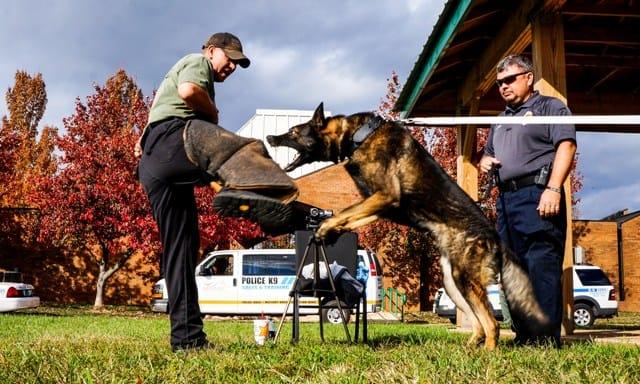In the bustling crossroads of law enforcement and animal partnership, police dog training emerges as a fascinating blend of discipline, intuition, and teamwork. These highly specialized canines, often seen patrolling our streets or aiding in critical search and rescue missions, represent the pinnacle of what humans and animals can achieve together when harnessing the power of instinct and intelligence. Yet, behind their poised demeanor lies a rigorous training regimen designed to prepare them for the complexities of their duties. From navigating urban environments to detecting narcotics, the training process is both an art and a science, requiring patience, skill, and a deep bond between handler and hound. In this exploration of police dog training, we will delve into the techniques, challenges, and profound relationships that define this unique field, shedding light on the unsung heroes who serve alongside our dedicated officers.
Table of Contents
- Understanding the Foundations of Effective Police Dog Training
- Essential Skills and Techniques for Police Canines
- Building a Strong Handler-Canine Bond for Optimal Performance
- Evaluating and Adapting Training Methods for Individual Needs
- Q&A
- Final Thoughts
Understanding the Foundations of Effective Police Dog Training
Effective police dog training builds upon a foundation of understanding both canine behavior and the specific needs of law enforcement operations. It is essential that trainers are well-versed in canine psychology, as this knowledge allows them to tailor training techniques to individual dogs. Key components of effective training include:
- Positive Reinforcement: Rewarding desired behaviors encourages repetition and strengthens the bond between the handler and the dog.
- Consistency: Regular training schedules and consistent commands help dogs understand expectations.
- Socialization: Exposing dogs to various environments, situations, and people is crucial to develop their adaptability and confidence.
Moreover, a successful training regimen often encompasses a variety of exercises tailored to different scenarios that police dogs may encounter. These may include obedience drills, search and rescue tasks, and protection skills. To optimize this process, trainers often utilize a structured approach, such as:
| Training Component | Description |
|---|---|
| Obedience | Fundamental commands like sit, stay, and come. |
| Tracking | Using scent to follow trails for search missions. |
| Detection | Identifying specific scents, such as drugs or explosives. |
| Protection | Teaching dogs to respond to threats or apprehend suspects. |
Essential Skills and Techniques for Police Canines
The foundation of effective police dog training lies in a mix of innate abilities and learned skills. Officers and their canine partners must cultivate a strong bond based on trust and respect. Essential skills include obedience, which involves the dog responding reliably to commands, and search techniques, enabling them to locate missing persons or detect substances. Furthermore, dogs must be proficient in tracking, which assists in following scents, providing vital support in criminal investigations. These core abilities are reinforced through consistent practice and positive reinforcement techniques, ensuring both the handler and dog are on the same page.
In addition to fundamental skills, specialized techniques enhance a police dog’s effectiveness in the field. Key areas of focus include:
- Aggression Control: Training police canines to exhibit controlled aggression only when necessary, ensuring public safety.
- Adaptive Problem Solving: Encouraging dogs to think critically in various scenarios, aiding in arrest operations.
- Alert Behaviors: Teaching dogs to signal when they detect specific scents, whether it be drugs or explosives.
To demonstrate the training process, the following table summarizes the skills and their corresponding training techniques:
| Skill | Training Technique |
|---|---|
| Obedience | Basic command drills |
| Search Techniques | Scent association exercises |
| Tracking | Follow scent trails with varied terrains |
| Aggression Control | Controlled exposure to stimuli |
| Alert Behaviors | Positive reinforcement for correct alerts |
Building a Strong Handler-Canine Bond for Optimal Performance
Establishing a robust relationship between the handler and the canine is fundamental to maximizing the effectiveness of police dog training. This connection fosters trust and communication, which are critical elements in high-pressure situations. The training process should integrate techniques that promote bonding, such as:
- Positive Reinforcement: Reward-based methods help create a sense of achievement and increase motivation.
- Consistent Commands: Using the same verbal cues aids in building understanding and reliability.
- Engaging Activities: Incorporating play sessions reinforces the handler-canine relationship while keeping the dog mentally stimulated.
A well-formed bond not only enhances the dog’s performance but also contributes to their overall well-being. Incorporating regular assessments can ensure the relationship is developing positively. Consider the following metrics to gauge the strength of the bond:
| Bonding Activity | Frequency | Effectiveness Rating (1-5) |
|---|---|---|
| Training Sessions | 3 times/week | 4 |
| Playtime | Daily | 5 |
| Walks | Every other day | 4 |
| Relaxation Time | Weekly | 3 |
Evaluating and Adapting Training Methods for Individual Needs
In the realm of police dog training, recognizing the unique abilities and characteristics of each canine is paramount. Different breeds may exhibit varying levels of drive, focus, and temperament, which necessitates a tailored approach to training. For instance, while some dogs may thrive in high-energy environments, others might require a gentle, more patient technique. Key considerations for adapting training methods include:
- Breed Characteristics: Understanding the natural instincts of the breed.
- Age and Experience: Tailoring strategies for puppies versus seasoned performers.
- Temperament: Adjusting based on a dog’s reaction to stress or excitement.
- Learning Styles: Incorporating visual, auditory, or kinesthetic methods.
The effectiveness of training can be further enhanced by implementing a data-driven approach. By keeping track of each dog’s progress, trainers can pinpoint areas needing improvement and strategies that resonate with the individual. A simple tracking system might look like this:
| Dog Name | Training Focus | Observations | Adaptations Needed |
|---|---|---|---|
| Rex | Agility | Excels in speed | Incorporate more complex obstacles |
| Luna | Tracking | Struggles with distractions | Use quieter environments |
| Buddy | Protection | High energy but prone to fatigue | Implement short, intense sessions |
By leveraging such data, trainers can make informed decisions on how best to adapt their methods, ultimately nurturing each dog’s potential and ensuring their readiness for real-life scenarios. Every dog is unique, and recognizing this individuality can dramatically enhance the overall efficacy of police dog training programs.
Q&A
Q&A on Police Dog Training: Unleashing the Potential of K9 Partners
Q1: What is police dog training, and why is it essential?
A1: Police dog training is a specialized process designed to equip dogs with the skills necessary to assist law enforcement in various tasks. These tasks can range from tracking suspects and detecting narcotics to apprehending dangerous individuals and crowd control. The training is essential as it enhances public safety and allows for a more efficient response to crime, ultimately serving as a vital tool in modern policing.
Q2: What breeds are commonly used for police work, and what makes them suitable?
A2: Several breeds are favored in police work, with German Shepherds, Belgian Malinois, Bloodhounds, and Labrador Retrievers leading the pack. These breeds are chosen for their keen sense of smell, intelligence, and trainability. For instance, Bloodhounds are renowned for their tracking abilities, while German Shepherds are often employed in patrol and protection roles due to their strength and loyalty.
Q3: How does the training process begin for a police dog?
A3: The training process typically begins at a young age, often around 6 to 12 months. Initial training focuses on basic obedience commands such as sit, stay, and come, which lay the groundwork for more advanced skills. Socialization is also crucial during this phase, ensuring that the dogs are comfortable around various people, environments, and distractions, which is essential for their future duties.
Q4: What kinds of skills do police dogs learn during their training?
A4: Police dogs are trained in a variety of skills, tailored to their specific roles. These can include:
- Narcotic Detection: Training to identify and alert handlers to various drugs.
- Tracking and Trailing: Learning to follow scents to locate subjects or evidence.
- Controlled Aggression: Understanding when to use force appropriately, often during apprehension.
- Search and Rescue: Assisting in locating missing persons or evidence in challenging environments.
Q5: How are handlers and dogs trained together?
A5: Handler and dog training is a synergistic process, crucial for the success of a police K9 team. Handlers undergo rigorous training themselves, focusing on understanding canine behavior, communication techniques, and tactical deployment. The bond between the handler and the dog is nurtured through exercises that promote trust and teamwork, often resulting in a close partnership that enhances operational effectiveness.
Q6: What challenges do trainers face during police dog training?
A6: Trainers encounter several challenges, including maintaining the dogs’ motivation throughout the training process, ensuring they remain focused amidst distractions, and managing the dogs’ drive for play and work. Additionally, recognizing individual canine personalities and adapting training methods accordingly is also essential, as each dog may respond differently to various training stimuli.
Q7: What impact does police dog training have on communities?
A7: The impact of police dog training on communities is significant. K9 units often act as a reassuring presence, fostering community trust in law enforcement. The efficiency and effectiveness of police work are enhanced through the unique skills that trained dogs offer, ultimately leading to a safer environment for all. Furthermore, successful operations involving K9s can increase awareness about various issues, such as drug abuse or crime prevention, encouraging community engagement.
Q8: How do police dogs retire, and what happens to them after their service?
A8: Upon retirement, many police dogs are afforded a dignified transition into civilian life, often remaining with their handlers as beloved family pets. Departments typically ensure these dogs receive necessary medical care, and some organizations help place retired K9s in new homes when they are unable to stay with their handlers. Whichever path they take, the focus remains on ensuring that these loyal companions enjoy a fulfilling retirement after their heroic service.
Conclusion: Police dog training is a multifaceted process that embodies the intersection of human and canine collaboration in the realm of law enforcement. Through dedication and expertise, trainers and handlers unlock the potential of these remarkable animals, making cities safer one paw at a time.
Final Thoughts
As we conclude our journey into the world of police dog training, it’s clear that these extraordinary canines are more than just companions; they are integral partners in ensuring public safety. The rigorous training they undergo not only hones their natural instincts but also strengthens the bond between dog and handler, creating a formidable team dedicated to serving the community.
From tracking down suspects to detecting narcotics and explosives, the skills that these dogs acquire represent countless hours of hard work, patience, and meticulous training. Behind every successful mission lies a story of resilience, trust, and a deep understanding of the unique language shared between humans and dogs.
As we continue to explore the evolving roles of police dogs in law enforcement, let us recognize and appreciate the vital contributions they make. Their unwavering loyalty and extraordinary abilities remind us of the profound connection we share with animals—one that transcends words and demonstrates the impact of teamwork in tackling the challenges of our society. In this ever-changing landscape, the bond between police dogs and their handlers remains a testament to courage, commitment, and the pursuit of justice.



